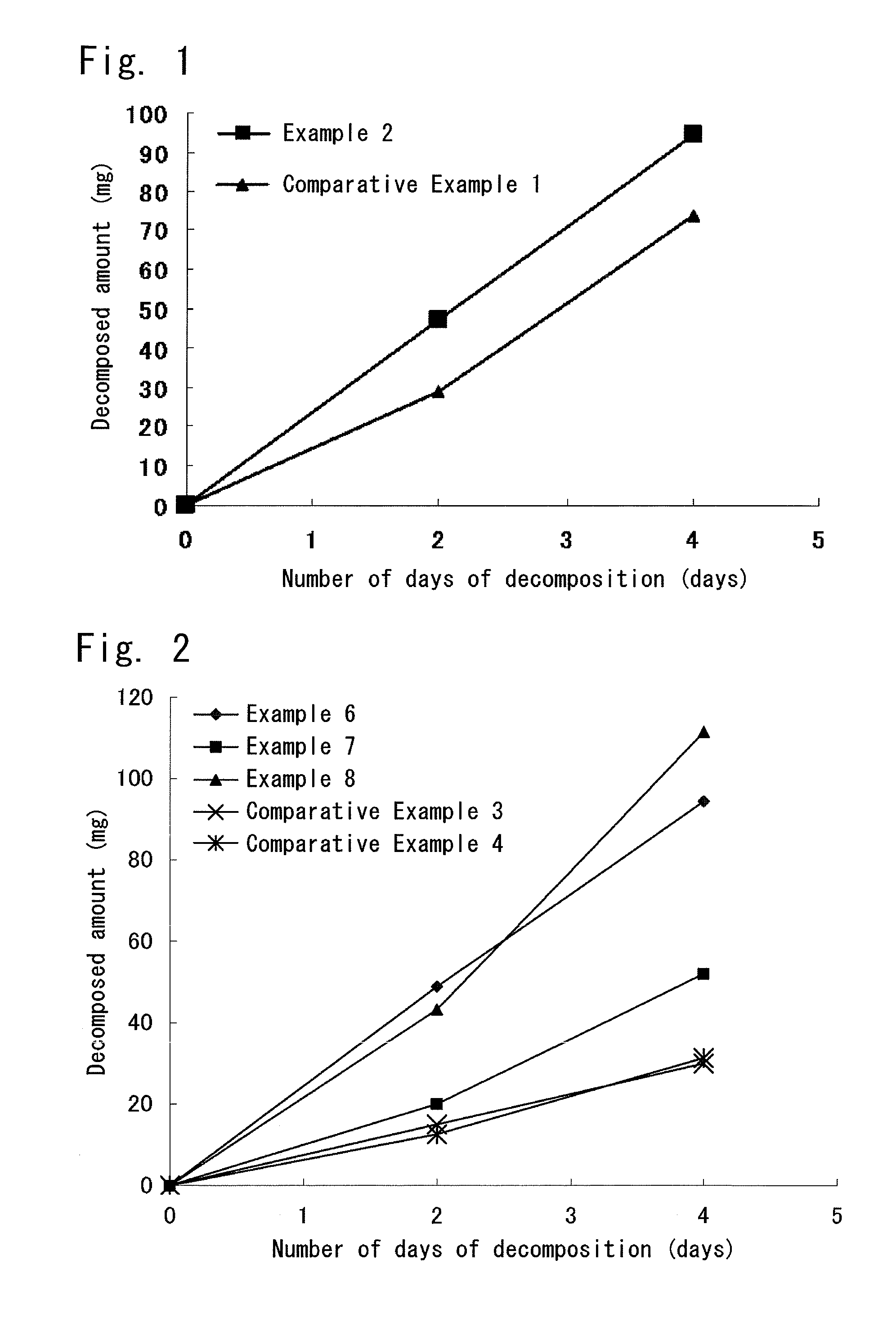Biodegradable resin composition
a technology of biodegradable resin and composition, which is applied in the direction of bio-packaging, sustainable packaging industry, climate sustainability, etc., can solve the problems of insufficient degree of biodegradation and only gradually releasing acid or alkali from the decomposition promoter, and achieve the effect of promoting the hydrolysis of polyglycolic acid, small initial rate, and small rate of hydrolysis
- Summary
- Abstract
- Description
- Claims
- Application Information
AI Technical Summary
Benefits of technology
Problems solved by technology
Method used
Image
Examples
examples
GPC by Using an HFIP Solvent.
[0057]Use was made of a GPC manufactured by Toso Co. and the HFIP-605 as the column. The temperature of the column oven was set at 40° C., an HFIP (hexafluoroisopropanol) was used as the eluent, and the flow rate was set to be 0.5 ml / min. The sample was injected in an amount of 15 μl. As a standard, a polymethyl methacrylate was dissolved in the HFIP. The sample was prepared by using the HFIP as the solvent and at a concentration of 2 mg / ml by passing it through a filter.
GPC by Using a Chloroform Solvent.
[0058]Use was made of a GPC, HCL-8120, manufactured by Toso Co., the TSKgel Super HM-Hx2 as the column and the TSKguard column Super H-H as the guard column. The temperature of the column oven was set at 40° C., a chloroform was used as the eluent, and the flow rate was set to be 0.5 ml / min. The sample was injected in an amount of 20 μl. As a standard, a polystyrene was dissolved in the chloroform. The sample was prepared by using the chloroform as the s...
examples 1 to 8
, COMPARATIVE EXAMPLES 1 TO 4
[0069]Various materials shown in Table 1 were blended together at predetermined ratios to prepare films according to the above-mentioned forming method. The obtained films were measured for their ratios of retention of the molecular weight and were tested for their enzymatic decomposition to obtain the results as shown in Table 1.
TABLE 1*1PGA / decomposition promoterBlendingBlendingratioMaterialratio*2*3*4Ex. 194:6PGA (Mw 100,000) / 2:1—∘95Ca carbonateEx. 294:6PGA (Mw 100,000) / 3:1—∘80Ca carbonateEx. 395:5PGA (Mw 100,000) / 1:1—∘80Ca carbonateEx. 494:6PGA (Mw 100,000) / 2:1—∘52zeoliteEx. 594:6PGA (Mw 100,000) / 0:2:1—x—Ca carbonateEx. 694:6PGA (Mw 200,000) / 2:1—∘94Ca carbonateEx. 794:6PGA (Mw 200,000) / 2:1—∘51zeoliteEx. 894:6PGA (Mw 200,000) / 2:14∘111Ca carbonate + Na ppmcarbonateComp.95:5PGA (Mw 100,000) / —5:0—∘73Ex. 1Comp.95:5PGA (Mw 200,000) / —5:0—∘37Ex. 2Comp.100———∘30Ex. 3Comp.94:6PGA (Mw 200,000) / 2:1—∘31Ex. 4chitosan*1: PLA / PGA + decomposition promoter*2: Amount ...
PUM
| Property | Measurement | Unit |
|---|---|---|
| Percent by mass | aaaaa | aaaaa |
| Biodegradability | aaaaa | aaaaa |
Abstract
Description
Claims
Application Information
 Login to View More
Login to View More - R&D
- Intellectual Property
- Life Sciences
- Materials
- Tech Scout
- Unparalleled Data Quality
- Higher Quality Content
- 60% Fewer Hallucinations
Browse by: Latest US Patents, China's latest patents, Technical Efficacy Thesaurus, Application Domain, Technology Topic, Popular Technical Reports.
© 2025 PatSnap. All rights reserved.Legal|Privacy policy|Modern Slavery Act Transparency Statement|Sitemap|About US| Contact US: help@patsnap.com

